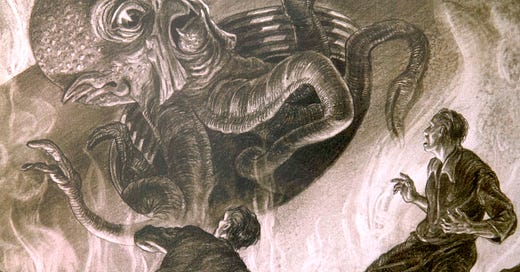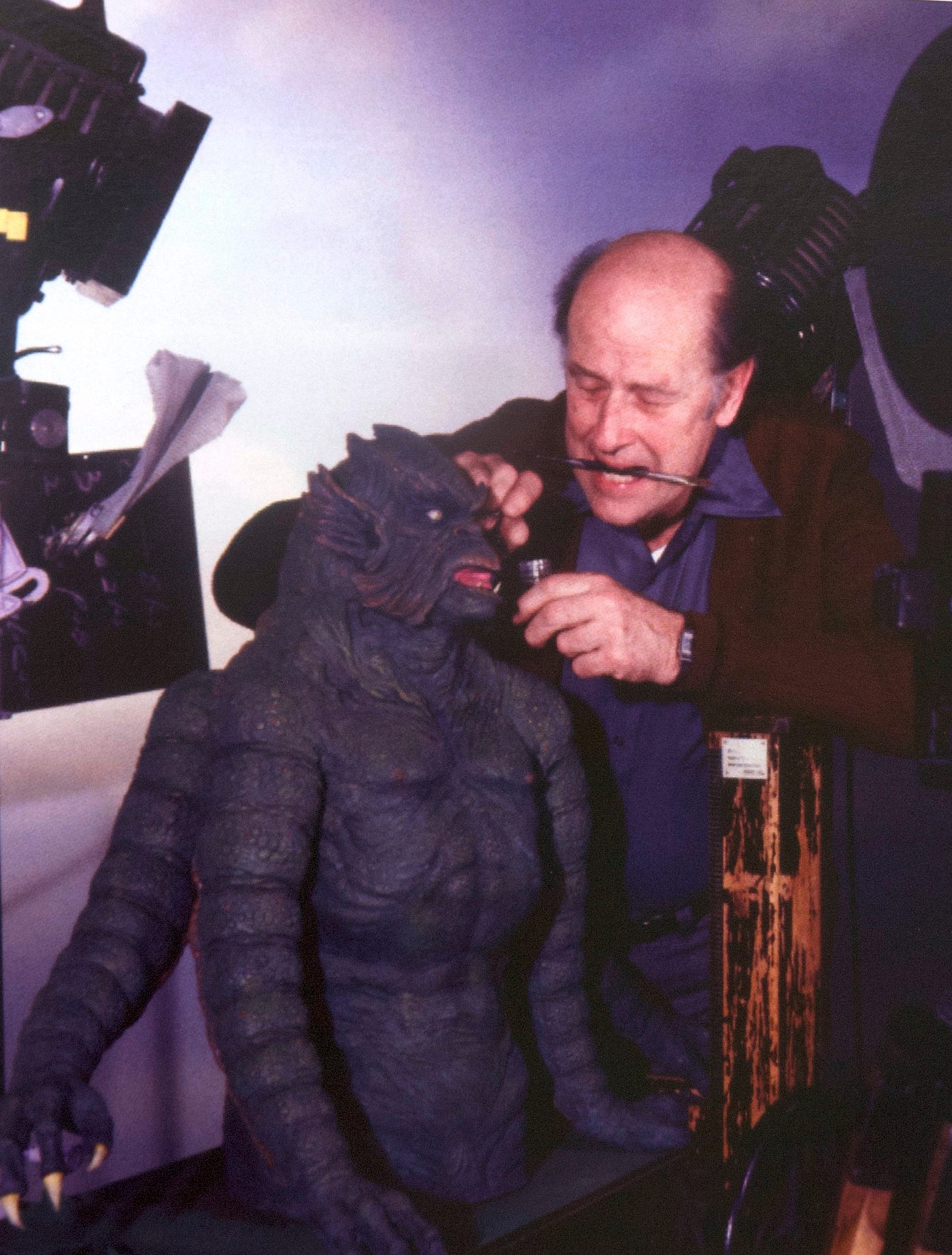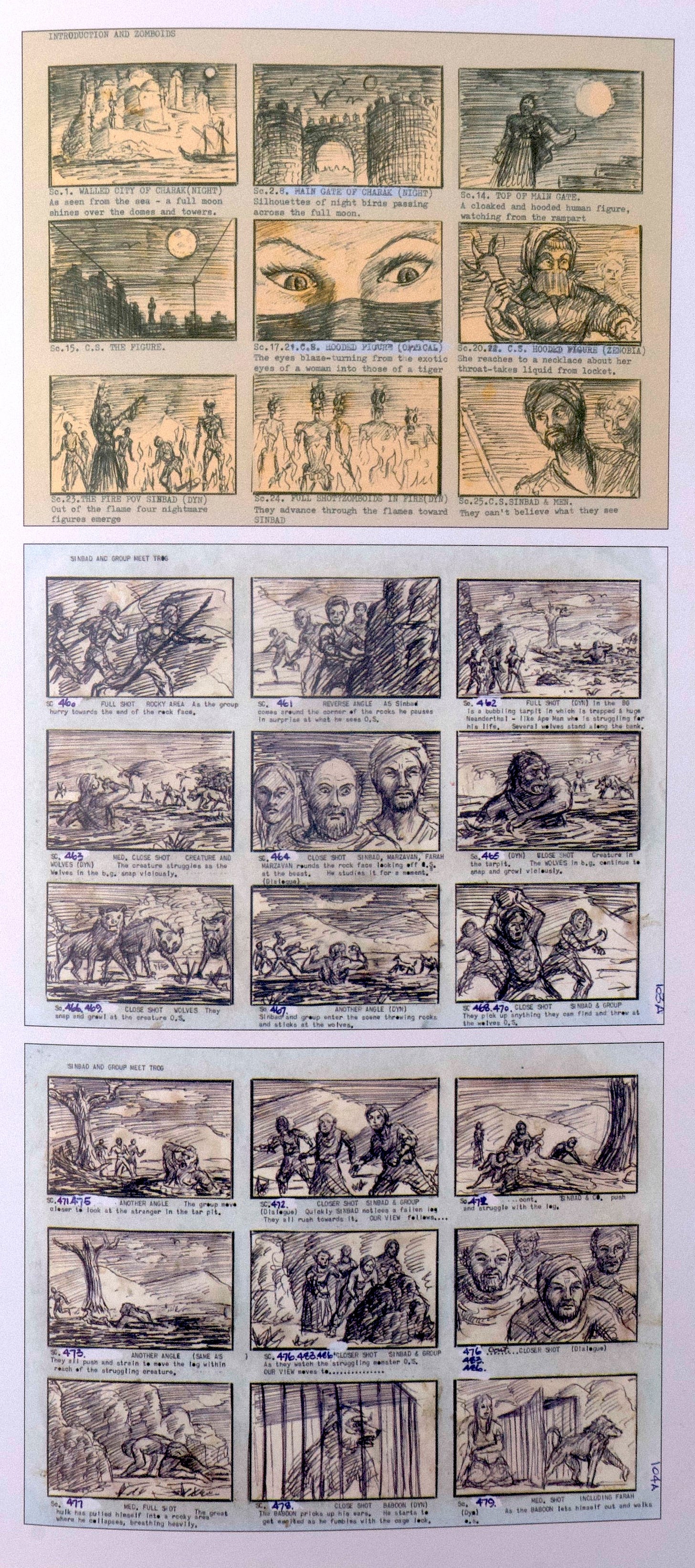Ray Harryhausen, the Maestro of Monster Magic
When I think of the depiction of monsters in film, I think of the name Ray Harryhausen. In this age of CGI and burgeoning AI, the legacy of Harryhausen’s work is fast receding in living memory and for the modern popcorn muncher, it’s probably fair to say that stop-motion, latex-covered automaton creatures, no longer pass muster. But this, perhaps, says more about how our imagination is being blunted rather than sharpened. When warriors gathered about the fire of the mead hall, the wailing winds of winter whistling about the thatch of the roof, all that was required was the measured poetic chanting of the skald to summon the fearful specter of Grendel and make it real in their wondering minds. The shadows cast by the fire would transmute into that monster of the weird, a ‘thyrs’ from elder times, sending a shiver down the spine of even the most battle-hardened thane…
Having matured in a time before the microchip became the commonplace tool of the modern home, I was haunted and inspired by the fantastic and visionary creatures that Harryhausen sent stalking across the silver screen, models brought to life like some necromantic homunculus, creeping upon our cinematic heroes with malign and horrific intent. For my part, I was terrified as a child by the bronze giant Talos, the massive creaking nemesis of the poet Hylas in the 1963 fantasy movie Jason and the Argonauts. I often imagined that implacable Titan peering into my bedroom window. This vision came, not through some night terror, but rather because on some deep level, I enjoyed being terrified even though just the thought of it was enough to send me burrowing deep under the covers of my bed. Seeing King Kong (1933) on tv had had a similar effect on me, certainly, a youthful case of megalophobia that was later to be compounded by my first reading of The Call of Cthulhu.
But I always relished that fear, it was a delicious, irrational shudder. An unconscious peek along the royal road of imagination into a realm of otherworldly possibilities.
Filmmaking the fantastic, like any storytelling, often requires the willing suspension of disbelief on the part of the audience. But in the hands of a master of the craft, such a suspension is made much more feasible.
Raymond Frederick Harryhausen (1920–2013) was such a master. An American-British animator and special effects creator, he developed a form of stop-motion model animation known as ‘Dynamation’. Previously, small-scale sets had had to be created for the ‘creature’ scenes. This was both expensive and time-consuming. Dynamation was an innovative technology that allowed the combination of live-action and stop-motion scenes. Harryhausen meticulously planned out both the creation of his monsters and the scenes in which they were to appear. And not only was he a filmic genius but his paintings and drawings (often inspired by his love of the work of Gustave Doré) were of the highest order too. His storyboards alone are a visual treat.
Inspired himself by King Kong, Harryhausen rose from a neophyte technician to an unassailable master of visual effects in movies. A select filmography demonstrates the arc of his career creating monsters, aliens, and dinosaurs:
Mighty Joe Young (1949, First technician)
The Beast from 20,000 Fathoms (1953, Visual effects)
It Came from Beneath the Sea (1955, Visual effects)
Earth vs. the Flying Saucers (1956, Special photographic/animation effects)
20 Million Miles to Earth (1957, Visual effects)
The 7th Voyage of Sinbad (1958, Associate producer, visual effects)
The 3 Worlds of Gulliver (1960, Visual effects)
Mysterious Island (1961, Special visual effects)
Jason and the Argonauts (1963, Associate producer, visual effects)
First Men in the Moon (1964, Associate producer, visual effects)
One Million Years B.C. (1966, Special visual effects)
The Valley of Gwangi (1969, Associate producer, visual effects)
The Golden Voyage of Sinbad (1973, Producer, visual effects)
Sinbad and the Eye of the Tiger (1977, Producer, visual effects)
Clash of the Titans (1981, Producer, visual effects)
I only saw three Ray Harryhausen movies in an actual cinema. There was The Golden Voyage of Sinbad (1973) when I was about eight years old (a year later Tom Baker, who played the evil magician Koura in that epic would become a Time Lord and spend the next seven years spinning about time and space battling countless manifestations of alien and terrestrial horror). The second Harryhausen film I caught on the silver screen was Sinbad and the Eye of the Tiger (1977) and finally, The Clash of the Titans (1981). And even at sixteen I still found the maestro’s monsters captivating. Indeed, seeing the creatures on the big screen heightened their magical effect.
A year later I was terrified by the work of another great of ‘weird’ cinema when I saw John Carpenter’s The Thing (1982) and although Carpenter decided to cut the stop motion scenes (you can see the stop motion work by animator Randy Cook in the cut scene here) The Thing was still a cinematic masterpiece without CGI.
I believe there is still a place for stop motion, in fact, I’m sure of it. CGI is long established now, and AI is here, and there can be no escaping those facts. But like all techniques, these are tools, that stand or fall according to the mastery of the wielder. There have been many innovations in the visual, imaginal realm of filmmaking. And sometimes they are used by the worthy and sometimes they are not.
For those younger readers who may not be familiar with Harryhausen’s work take a look at his portfolio of monsters. Clip scenes from his movies are freely available to view, and you might just feel the magic... And, if you are a ‘creative’, well, you might even breathe new life into it yourself. I challenge you to try to not be impressed by the fight scene with the skeletons in Jason and the Argonauts with its haunting, clattering soundtrack.
In the summer months, I like to sit out in my garden of an evening and write. It’s peaceful here, out in the quiet of the country surrounded by low, wooded hills. But sometimes, when twilight is past and night casts its deep cloak over the landscape, I hear the monstrous tread of an approaching leviathan, its vast silhouette rising to blot out the stars. And I shudder and smile as the memory of a Harryhausen titan looms once more into my imagination...












